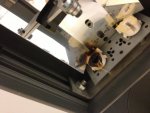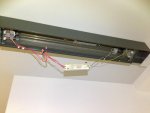any idea why these sockets after these workhorse ballasts should be failing in record numbers?

it is the workhorse 5 and two f54 lamps
nominal 120v
the fixtures are pretty well enclosed.
I'll do some thermal imaging later this week.
The ballasts were never screwed into the enclosure. Apparently they were glued in at the factory.
Some of the fixtures are on dimmers, but I can't believe that there are any workhorse ballasts in there.
I haven't taken the fixtures after the dimmers apart yet.
Some sockets had loose wires, but that could be because... they were melted!
What should I be looking for, what could be overdriving these ballasts, causing such heat at the sockets?
lack of grounding? could that do it?
dimmers... sure
temperature? enclosed fixture
loose wires at the sockets, cheap sockets

it is the workhorse 5 and two f54 lamps
nominal 120v
the fixtures are pretty well enclosed.
I'll do some thermal imaging later this week.
The ballasts were never screwed into the enclosure. Apparently they were glued in at the factory.
Some of the fixtures are on dimmers, but I can't believe that there are any workhorse ballasts in there.
I haven't taken the fixtures after the dimmers apart yet.
Some sockets had loose wires, but that could be because... they were melted!
What should I be looking for, what could be overdriving these ballasts, causing such heat at the sockets?
lack of grounding? could that do it?
dimmers... sure
temperature? enclosed fixture
loose wires at the sockets, cheap sockets

